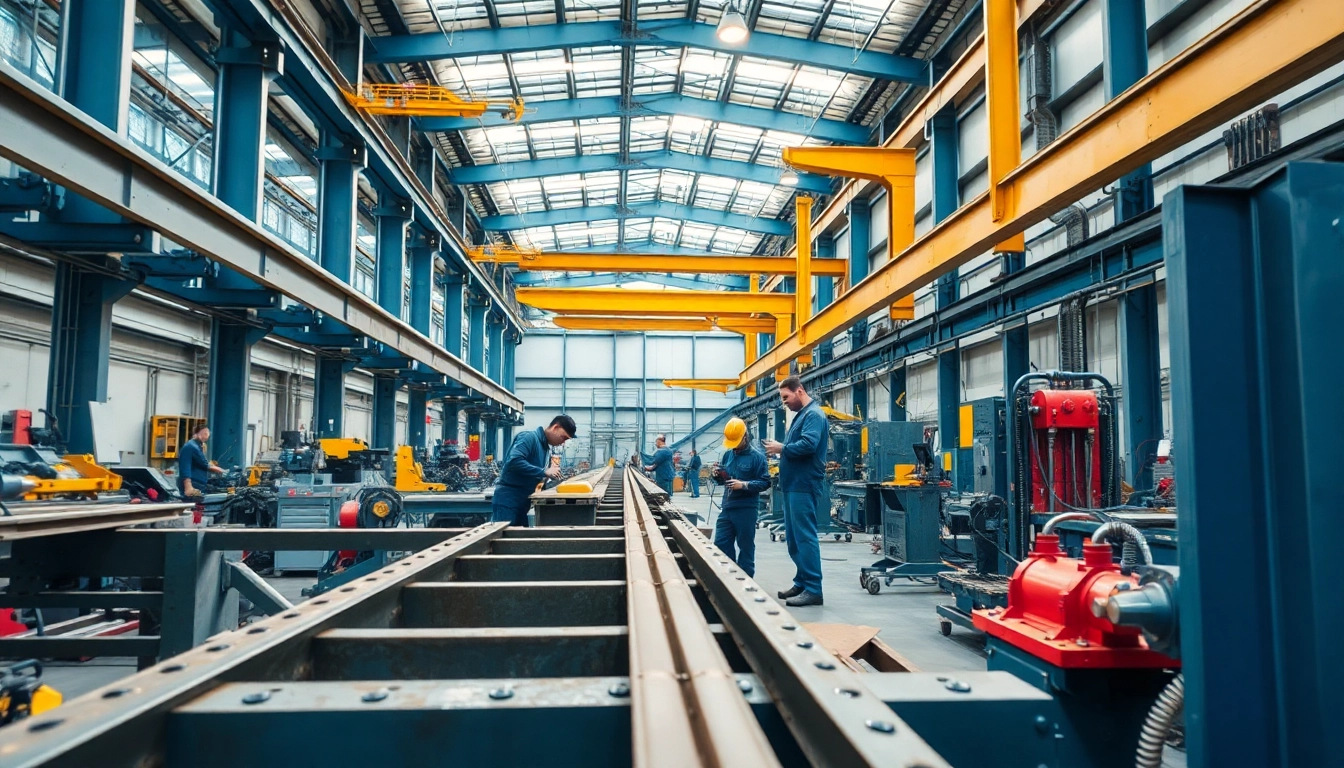Understanding Industrial Fabrication in Edmonton
Definition and Importance of Industrial Fabrication
Industrial fabrication is the process of creating metal structures and components through various techniques and methods, essential for a wide range of industries. In Edmonton, as in many urban centers, industrial fabrication plays a pivotal role in supporting the local economy. This process not only involves the fabrication of metal parts but also encompasses design, engineering, and assembly to meet specific project requirements. As industries evolve, the demand for industrial fabrication in Edmonton is increasing, emphasizing its critical role in various sectors such as construction, manufacturing, and energy.
Key Industries Utilizing Fabrication Services
Several key industries in Edmonton rely heavily on industrial fabrication services. The oil and gas sector is perhaps the most notable, as it requires specialized equipment and structures for exploration, drilling, and refining processes. Additionally, the construction industry utilizes fabrication for creating steel frameworks, roofing systems, and infrastructure components.
The manufacturing sector also benefits from industrial fabrication, with companies producing machinery, tools, and consumer products that require precise metal components. Additionally, sectors like aerospace and transportation leverage fabrication services for the production of lightweight and durable components that meet stringent safety standards.
Historical Growth and Overview of Edmonton’s Fabrication Scene
Edmonton’s fabrication scene has undergone significant transformation over the decades. Historically centered around oil and gas, the city has diversified its fabrication capabilities to serve various industries better. With advancements in technology and the rise of skilled labor, local fabrication shops have expanded their offerings to include high-precision machining, custom fabrication, and rapid prototyping.
Today, Edmonton boasts a thriving industrial fabrication ecosystem, with numerous businesses employing skilled tradespeople and utilizing modern technology to foster innovation. This growth is essential as the city aims to compete globally and adapt to ever-changing market demands.
Essential Techniques in Industrial Fabrication
Welding Methods and Applications
Welding is one of the most critical techniques in industrial fabrication, as it involves joining metal components to create strong, durable structures. Various welding methods exist, each with its applications and advantages. The most common types include MIG (Metal Inert Gas) welding, TIG (Tungsten Inert Gas) welding, and Stick welding.
MIG welding is favored for its speed and ability to weld thin materials, making it ideal for automotive and thin-sheet applications. On the other hand, TIG welding offers superior control, allowing for precise applications, especially in industries where aesthetics and neatness are crucial, such as in the culinary equipment sector. Stick welding, known for its versatility and ability to work in challenging conditions, is often employed in construction and repair work.
Cutting Techniques for Precision Work
Precision cutting is vital in industrial fabrication to ensure that components fit together correctly and meet design specifications. Common cutting techniques include plasma cutting, laser cutting, and water jet cutting.
Plasma cutting is known for its speed and ability to cut through thicker materials, making it useful in heavy industrial applications. Laser cutting provides exceptional precision and is used for more intricate designs, while water jet cutting is ideal for materials sensitive to heat, such as rubber and plastics. Each technique has its place in the fabrication process and is selected based on the specific requirements of the project.
Assembly Processes and Best Practices
Once components are fabricated and cut, the next step is assembly. Effective assembly processes are crucial for ensuring the integrity and functionality of the final product. Best practices in assembly include using jigs and fixtures to hold parts in place during assembly, ensuring that tolerances are maintained throughout the process.
Moreover, employing skilled workers who understand the nuances of fitting components together can lead to a significant reduction in error rates. In addition, ongoing training and adherence to safety protocols are essential to maintaining a safe and efficient working environment.
Choosing the Right Fabrication Service in Edmonton
Factors to Consider When Selecting a Provider
Selecting the right fabrication service can make or break a project. Key factors to consider include the service provider’s expertise in specific industries, their capacity to handle the required volume of work, and their technology and equipment. Moreover, company reputation and past client satisfaction are critical indicators of reliability.
Prospective clients should also evaluate the fabrication shop’s quality assurance processes and any certifications they hold, such as ISO standards, which ensure adherence to industry best practices. These factors collectively contribute to the overall quality of the fabricated products.
Comparing Costs and Quality
While cost is a significant factor in choosing a fabrication service, it should not be the only criterion. It is essential to balance the quality of work against the costs involved. Cheaper options may lead to compromises in materials or craftsmanship, resulting in higher long-term costs due to rework or failure.
Clients should ask for detailed quotes that outline what is included in the service. Moreover, consider the lifetime value of the fabricated components, as investing in quality may yield better performance and longevity.
Case Studies: Successful Fabrication Projects
Examining successful fabrication projects offers valuable insights into the capabilities of providers. For instance, one prominent case in Edmonton involved the fabrication of custom steel frames for a new high-rise building. The chosen fabrication company used advanced technology to produce an accurate, fit-for-purpose solution efficiently and within budget.
The project illustrated the critical role of precision engineering and effective communication with the client from conception to completion, highlighting how productive collaboration can lead to successful outcomes.
Challenges Facing the Fabrication Industry Today
Supply Chain Interruptions and Material Shortages
The fabrication industry is not immune to the broader challenges of supply chain interruptions and material shortages that have been exacerbated by global events. These disruptions can lead to increased costs, delays, and in some cases, project cancellations. Fabricators must develop robust relationships with multiple suppliers to mitigate risks and ensure they can source the necessary materials in a timely manner.
Establishing partnerships with local suppliers can also enhance resilience by reducing reliance on distant suppliers and decreasing transportation costs.
Technological Advancements and Adaptations
Technological advancements are reshaping the fabrication landscape, with innovations such as robotics, automation, and digital fabrication tools becoming increasingly prevalent. While these advancements offer significant efficiency gains and precision, they also present challenges related to workforce training and adaptation to new methods. Fabricators must invest in employee training to harness these technologies effectively, ensuring that their workforce remains relevant and capable of meeting future demands.
Sustainability Practices in Fabrication
Sustainability is increasingly becoming a focus in the industrial fabrication sector, driven by regulations and market demands for environmentally friendly practices. Fabricators are now exploring ways to minimize waste, reduce energy consumption, and utilize recyclable materials in their processes. Implementing these practices not only aligns with corporate social responsibility initiatives but can also lead to cost savings over time.
Practices such as lean manufacturing and sustainable sourcing can significantly enhance a firm’s sustainability profile, making them more attractive to environmentally conscious clients.
The Future of Industrial Fabrication in Edmonton
Emerging Trends and Innovations
The future of industrial fabrication in Edmonton holds promise, with several emerging trends poised to shape the industry. Digital fabrication technologies like 3D printing are beginning to gain traction, allowing for faster prototyping and customization. Moreover, the rise of smart factories integrated with the Internet of Things (IoT) is fostering greater connectivity between equipment, workers, and supply chains.
These innovations are creating opportunities for increased efficiency and responsiveness, allowing fabricators to better meet the unique demands of clients across various industries.
Impact of Automation and AI on Fabrication
Automation and artificial intelligence (AI) are set to transform industrial fabrication further. AI algorithms can optimize production schedules and reduce downtime, while automated machinery can perform repetitive tasks with significant speed and accuracy. This technological shift may lead to increased productivity, although it raises questions regarding workforce displacement and the need for reskilling workers to take on more complex roles within the fabrication process.
Fostering a culture of innovation and adaptability will be crucial for businesses aiming to remain competitive in a landscape increasingly influenced by automation.
Opportunities for Growth in the Local Market
As Edmonton continues to evolve industrially, numerous growth opportunities are present in the fabrication sector. Expanding into new markets, such as renewable energy and environmental technologies, presents a formidable avenue for growth in the local fabrication industry. By embracing innovation and sustainability, fabricators can attract a diverse clientele and position themselves as leaders in the evolving marketplace.
Collaborations with local universities and research institutions can also pave the way for technological advancements and new methodologies that keep Edmonton’s fabrication industry at the forefront of the national economy.



